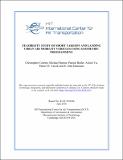| dc.description.abstract | Electric Short Takeoff and Landing (eSTOL) vehicles are proposed as a path towards implementing an Urban Air Mobility (UAM) network that reduces critical vehicle certification risks and offers advantages in vehicle performance compared to the widely proposed Electric Vertical Takeoff and Landing (eVTOL) aircraft. An overview is given of the system constraints and key enabling technologies that must be incorporated into the design of the vehicle. The tradeoffs between vehicle performance and runway length are investigated using geometric programming, a robust optimization framework. Runway lengths as short as 100-300 ft are shown to be feasible, depending on the level of technology and the desired cruise speed. The tradeoffs between runway length and the potential to build new infrastructure in urban centers are investigated using Boston as a representative case study. The placement of some runways up to 600ft is shown to be possible in the urban center, with a significant increase in the number of potential locations for runways shorter than 300ft. Key challenges and risks to implementation are discussed. | en_US |
